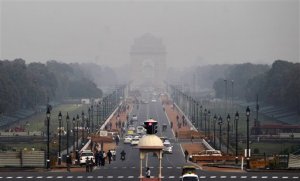The Emerging Indian Colossus
A 10-day visit to India this month kindled thoughts about a part of the world I have known only through novels and Merchant/Ivory movies.
The ambitions and dreams of the place are huge. Indian newspapers speculate avidly about a second Indian mission to Mars. (Did you even know about the first one, completed just two months ago?) I was blown away by a tour of a new planned city, Naya Raipur, being built in Chhattisgarh province, an obscure area of heavy industry and relatively backward “tribal” peoples. Rising from the plains of Naya Raipur are solar arrays, carefully planned infrastructure, lakes, recreational areas, and mixed commercial, office, and residential developments. It’s an immense undertaking to build an entirely new city of a half-million people, and they’re doing it.
India’s diversity is stunning. In ten days of traveling, we passed through areas in which the dominant local tongues were – in no particular order – Telugu, Hindi, Urdu, Punjabi, and Chhattisgarh. And there are many more, though English remains the language of business throughout the nation.
The physical realities of India are daunting. The air pollution is catastrophic. New Delhi has replaced Shanghai as the urban area with the worst air quality on the planet. New Delhi air makes sinuses burn and has to have severe health effects. Like London in the 1880s, or Pittsburgh in the 1950s, the atmosphere is simply poisonous.
Committed to a coal-fired future, India may single-handedly cancel out the efforts of every other nation on earth to control climate change. In the photo from February 2013 below, smog envelops the giant India Gate landmark in New Delhi.
Indian roads are often inadequate, public transport overwhelmed, and basic utility services inconsistent, at best. My wife, Nancy Floreen, asked the mayor of a large Indian city what his major priority is. “Drainage,” he answered. The day before, a woman in that city drowned in an overflowing drainage ditch.
The emergence of a large prosperous class in India underscores the brutal poverty of the nation’s majority. One-room squatters’ huts of plastic and scrap wood crouch next to modern mid-rise buildings.
In plush urban hotels, the capacious public washrooms were larger and dramatically more comfortable than the living quarters of the attendants who offered me hand towels with unfailing courtesy. In Chhattisgarh state, home to new-city Naya Raipur, fourteen women died this month from tainted drugs in government-sponsored sterilizations.
Every day’s newspaper brought fresh revelations of official corruption. While in Chhattisgarh, we read about the deputy head of the housing commission who used his public office to amass eighteen bank accounts, five houses, nine retail establishments, and large stocks of gold, jewelry, and silver.
The caste structure of old India persists and thwarts social mobility. The oppression of women is everywhere visible. They sweep streets with brooms made of ragged sticks, and grub in gardens in filthy clothes. On six domestic airline flights, we rarely saw an Indian female other than flight attendants. More seriously, the tradition persists of “honor killings” when a woman dishonors her family by, for example, marrying below her caste; an estimate 1,000 such killings occur every year.
Yet the ambition, talent, and sheer size of India (1.3 billion people) create the potential for great achievements. The nation’s unwieldy democratic processes – it is the largest democracy on the planet – has finally yielded a majority government with an energetic leader (Narendra Moti) who is goading the nation to clean up corruption and itself. On our tour, we met a range of impressively competent, urbane, and well-trained businesspeople, scientists, and professionals. On the flight home, we ran into two Washington-based acquaintances who had been in India on business. India is on the move.
At the beginning of the 20th century, Leon Trotsky had the insight that nations that come late to modernization can leapfrog developmental steps that pioneers had to trudge through. Modern telecommunications is an example of Trotsky’s “law of uneven and combined development.” Nations like India never developed a wired telephone industry. Instead, they used mobile phone service to jump over that step. Indians are madly working to make many more such leaps.
A final thought about this remarkable place. To survive in a crowded, clawing society, its people develop extraordinary skills. Road traffic is a grinding war of all-versus-all. Four-lane highways accommodate as many as seven lanes of traffic among drivers who don’t flinch until another vehicle threatens immediate annihilation. Indeed, Indian drivers fall into only two categories: (i) excellent ones, and (ii) dead ones. There is no middle ground. Pedestrians are almost always at risk.
An Indian man traveling with us suggested that his nation’s linguistic diversity and traffic madness actually foster a culture of gifted computer code writers. On the streets, they must remain aware and alert around all 360 degrees of the compass. To navigate through their world, they must master the grammar and structure of multiple spoken languages. Those skills, he argued, are essential traits for good code writers.
Keep an eye on India. Great and terrible things will continue to come from there.




Thanks for writing this blog! Fascinating insight.